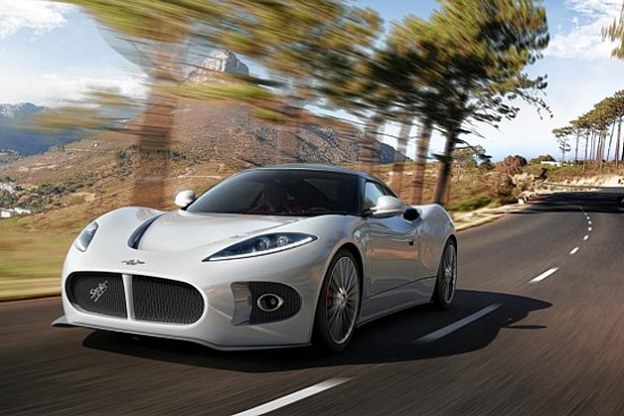 For the past few weeks, Spyker Cars has been teasing the press with the promise of a concept car, set to debut at the Geneva Motor Show later this week. However, the Dutch carmaker couldn’t resist showing off its B6 Venator in the Wall Street Journal first.
For the past few weeks, Spyker Cars has been teasing the press with the promise of a concept car, set to debut at the Geneva Motor Show later this week. However, the Dutch carmaker couldn’t resist showing off its B6 Venator in the Wall Street Journal first.
Spyker obviously hasn’t confirmed anything, but the car in the above photo definitely looks like it came from the same company that built the Victorian C8. It’s a low-slung, mid-engined sports car with a more updated look, but some of the same jewelry (check out those vents behind the doors).
Like the C8, it has more presence than conventional sports cars, although some of the details may need to be toned down. The spine in the middle of that huge grille makes the B6 look like it needs to floss, and the headlights look out of place, like they were taken from a Ferrari F430.
Rumor has it that the B6 will compete with the Porsche 911, but Spyker CEO Victor Muller said that is not the case.
“Anybody who says [we’re] going to build a Porsche killer is crazy,” Muller told the Wall Street Journal. Until now, Spykers haven’t competed directly against other sports cars on performance (although they are very quick) or price, instead relying on style and exclusivity to stand out.
The B6 Venator will be close in size to a Porsche Boxster, and will be close to a Lotus Evora in terms of specifications. Like the Lotus, it will be powered by a mid-mounted V6.
The engine will produce 375 horsepower and will come with a six-speed automatic transmission. Muller did not name an engine supplier; the C8’s 4.2-liter V8 comes from Audi.
The new Spyker will also be extraordinarily light. An aluminum chassis and carbon fiber body should help it meet a target weight of under 3,080 pounds.
The name is a nod to Spyker’s heritage. Venator is Latin for “hunter,” and during World War I. the Dutch called fighter planes “hunters.” Many of these planes were built by Spyker.
When it goes on sale, the B6 Venator will cost between 125,000 and 150,000 euros, with production limited to a few hundred cars.
Muller has described the B6 as the the spearhead of Spyker’s “global resurgence,” which may be an overstatement if it turns out to be a limited-production affair like the C8.
Nonetheless, having an all-new car for the first time since the company’s 1999 resurrection is a sign of progress. Hopefully, it also means we’ll see more of these radical cars on the road.


